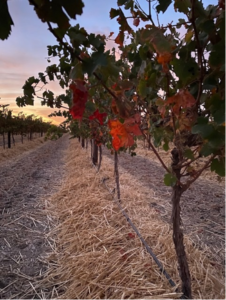Background
Several different tools are used by wine-grape growers across Australia to manage undervine weeds without chemicals. Most growers use a combination of different tools to achieve good weed control.
Mulches are spread undervine to help with moisture conservation and to add nutrients to the soil. High rates of mulch can also help to suppress weed growth. Various organic materials can be used as mulches.

Figure 1. Straw mulch spread undervine using a Kuhn Primor Straw Blower (image courtesy of Steve Schiller)
Action
Straw mulch suppresses weed germination by blocking sunlight from the weed seeds and their germinants. Some crop species that are used to make straw produce allelopathic chemicals, which can help to suppress weed growth. Generally, wheat or triticale straw is used, as their rate of breakdown is slower than other crops.
Advantages and disadvantages
Advantages: Straw mulch use provides long-term weed control (two to three years). It can be used in blocks with large or excessive stones where other tools cannot be used, and where tillage and mowing are difficult. Straw helps keep the soil surface cool and protected from evaporative water losses. It provides a source of carbon and does not disturb the soil, which can contribute to improved soil health. There is no risk of damage to vines from this practice.
Disadvantages: Straw mulch can increase frost risk in frost-prone areas and increase fire risk. It can create issues with trafficability, particularly in narrow rows (<2 m) and may be disturbed by grazing animals or flooding. Straw mulch can also harbour snails and other pests. In vineyards of low fertility, nitrogen drawdown caused by the straw can reduce vine growth unless supplementary nitrogen is applied.
Table 1. Advantages and disadvantages of straw mulch
| Ability to reduce weed competition with vines | Good |
| Soil disturbance caused | None |
| Suitability in young vineyards | Good |
| Length of weed control | Good |
| Operating speed | n/a |
| Operating cost | Good |
| Capital cost | Average |
Considerations
When considering which weed control tools to use, it is important to base the decision on each vineyard’s individual characteristics. Factors such as soil type and condition; slope; rainfall and water availability; weed pressure; vine age, vine vigour; fruit end-use targets; weather conditions and compatibility with existing infrastructure and equipment should all be considered.
When considering straw mulch, it is important to consider its impact on vineyard trafficability, particularly in vineyards with narrow rows, as well as the impact on frost and fire risk.
It’s recommended to check the straw supplier’s spray diary to ensure the chemicals used in the straw production are not going to adversely affect vine growth (e.g. Lontrel®). Growers should also make sure the straw is free from weed seeds and pests.
Table 2. Ease of using straw mulch on different soil types
| Large or excessive stones | Easy |
| Stone/gravel | Easy |
| Sand | Easy |
| Silt/loam | Easy |
| Clay | Easy |
Straw mulching tips
- Use only in vineyards with rows wider than 2 m.
- If using a straw blower to spread the straw mulch undervine, consider sourcing straw cut into 20-30 cm lengths to make it easier to spread.
- For good weed control, spread 11t/ha of straw mulch undervine every three years (a 20 cm straw mulch layer is recommended for weed suppression).
Growers’ experiences
Henschke spreads compost undervine at a rate of 100 m3/ha and triticale straw mulch on top of the compost at a rate of 50 bales/ha every three years in its Eden Valley and Adelaide Hills vineyards. The straw helps to retain soil moisture and inhibit weed growth while the compost is applied as a source of nitrogen and organic matter. Henschke has found that the straw provides excellent control of most weeds undervine. However, it does stimulate a fringe of weed growth along the straw edge, which requires management using strategic sheep grazing, mowing, undervine whipper-snipping or applications of Slasher, an organic herbicide.
In the Barossa Valley, SA, Steve Schiller spreads wheat straw mulch at a rate of 11 t/ha every three years, using a straw blower spreading machine. This rate provides good weed suppression and also reduces soil moisture losses from run-off and evaporation. Steve finds that sourcing the straw locally significantly reduces the applied cost.
Resources
Organic Winegrowers New Zealand. 2017. Undervine weed management – A practical guide to effective weed control in organic vineyards.
Contact
For further information, please contact:
AWRI helpdesk
Phone 08 8313 6600 Email helpdesk@awri.com.au

